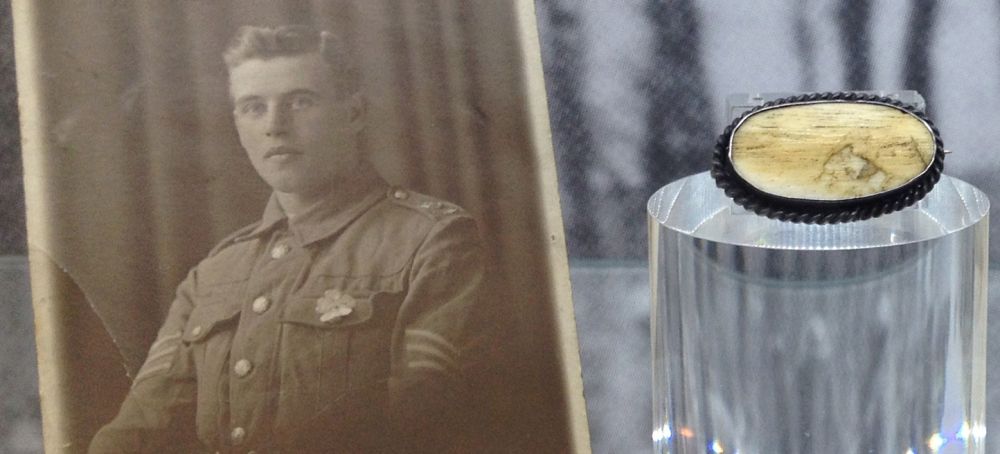
A brooch crafted from a piece of human thigh bone is among the items selected for an exhibition about the First World War at the University of Leeds.
Little is known about the rather macabre piece of jewellery, which is part of the University’s unrivalled archive of items and documents from the war.
It was made from a piece of Sergeant Thomas Kitching’s thigh bone and is thought to have been given to his sweetheart, Lizzie Hunter.
Sgt Kitching, who served with the 12th Battalion, Durham Light Infantry, had his left leg shattered when wounded on the Somme on 7 July 1916 – a week after the beginning of the notoriously bloody battle.
The brooch, together with a portrait of Sgt Kitching and postcards sent to Lizzie at her Birtley, County Durham, address, were donated to the University’s Liddle Collection.
He survived the war and went on to marry Lizzie in Chester-le-Street, County Durham, shortly after the war ended in 1918.
The unusual piece of jewellery is among many items selected for a special free exhibition inThe Stanley & Audrey Burton Gallery at the University, which runs until Saturday 20 December.
The exhibition, The Individual Remains: Untold Stories of the First World War, includes letters from and to the troops, photographs, medals and servicemen’s artwork. Together, they tell the different stories of the conflict, from underage soldiers to conscientious objectors and the Christmas truce of 1914. Other trench art includes vases made from shell cases.
University of Leeds student, Timothy Forster, who was part of a group of masters students who selected the items for the exhibition, said: “The brooch is a bizarre and rather puzzling item that has prompted lots of questions. We’d love to find out more about it.
“We hope we have used these poignant personal items of people who lived through the First World War to present perspectives of the war that are sensitive to the experiences of individuals represented within the Liddle Collection.”
Dr Helen Graham, who tutors the students on the MA Art Gallery and Museum Studies course and coordinated the exhibition, said: “The students have done an absolutely incredible job of crafting a sharp narrative out of a massive collection, in a vast topic, at a time where there are hundreds of First World War exhibitions everywhere. They have really said something about the personal legacies of the individuals in the collection.
“At the start of the course, we introduce the students to the University’s varied collections and ask them to work together to put on an exhibition, in a very short timeframe, as part of their learning experience.”.
For more details about Legacies of War, the University of Leeds 1914-18 centenary project, see http://arts.leeds.ac.uk/legaciesofwar/
Further information
Please contact the University of Leeds Press Office on +44 (0)113 343 4031 or email pressoffice@leeds.ac.uk
The free exhibition is in the Education Room at The Stanley & Audrey Burton Gallery within the Parkinson Building, Woodhouse Lane, LS2 9JT. It is open from Monday-Saturday, 10am-5pm. For more details, call 0113 343 2778 or email gallery@leeds.ac.uk
The title of the exhibition comes from Peter Liddle’s The British Soldier on the Somme in 1916: “…[A]n acceptance of military discipline and in section, platoon, company and battalion experience, will have necessarily worn away that manifestation of individual freedom of expression and action which the average Briton instinctively feels is part of his heritage. Nevertheless, in his soul, as might be recorded in letter or diary, the individual remains with his personal qualities, feelings, needs, revealed or concealed."
A free online short course about the First World War is offered by the University of Leeds in partnership with the BBC. For more details of WW1: Changing Faces of Heroism, which runs from 9 March, see https://www.futurelearn.com/courses/ww1-heroism